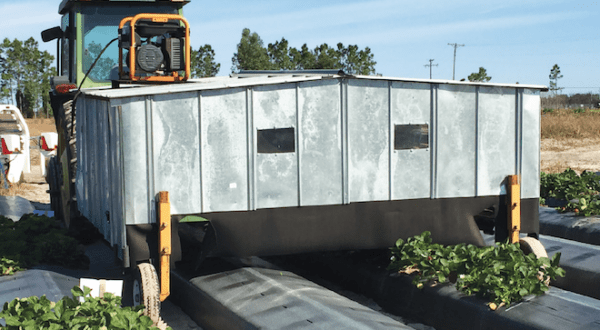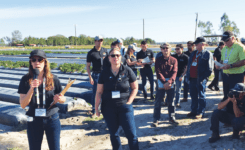

Apr 16, 2019Lights, steam tackle strawberry disease
A machine that can be programmed to traverse through fields shines a light to help prevent powdery mildew from causing damage to strawberries.
Natalia Peres, a professor of plant pathology at the University of Florida Institute of Food and Agricultural Sciences, works with a global group of scientists studying how to use ultraviolet light to suppress plant pathogens such as powdery mildew.
Peres reported on several strategic management approaches to ward off multiple diseases in strawberry nurseries and production fields during the North American Strawberry Symposium and North American Strawberry Growers Association annual meeting and tour based in Orlando, Florida, in early February.
“Current nursery practices often produce plants cryptically infected by one or more destructive pathogens,” Peres wrote in an introduction to her presentations. “Pathogens that are distributed with the plants may already have resistance to one or more key fungicides. Both aspects presently go undetected until plants reach production fields and losses occur.”
“Management of the critical issue of asymptomatic infections and fungicide resistance require breaking epidemic cycles with a reduced number of single-site fungicides,” Peres said.
Peres said alternatives to reduce fungicide usage to suppress a broad array of destructive pathogens have been developed and refined by researchers: aerated steam, nighttime applications of UV and expansion of the Strawberry Advisory System.


Peres and researchers at Rensselaer Polytechnic Institute (RPI) and Cornell University – both in New York state — are pioneering research on novel uses of light to suppress pathogens in several specialty crops, according to a news release. The group also includes scientists from Norway.
“It’s an exciting area, and our local strawberry growers have been great in allowing us to demonstrate the technology on their farms,” Peres said.
The team developed a tractor-drawn machine with several UV lamps. A breakthrough in the research took place when Norwegian researchers discovered that the treatments were more effective when applied at night, said Peres, a faculty member at the UF/IFAS Gulf Coast Research and Education Center in Balm, Florida.
The mildew pathogen evolved to survive natural UV in sunlight, Peres said. But part of that adaptation to sunlight resulted in the pathogen not being able to defend against natural UV light at night. So, nighttime UV applications bypass the natural defenses of the pathogen by delivering a small blast of UV light when the light catches the pathogen napping, Peres said.
The new technology has been tested at UF/IFAS Gulf Coast REC strawberry fields and at Wish Farms in Duette, Florida.
Similar trials are being conducted across North America and Europe by the research collaborators on crops such as grapes, hops and cucumbers, she said.
In addition to Peres, the multi-disciplinary research team includes scientists at RPI, Cornell University, the Norwegian University of Life Sciences, the Norwegian Institute of Bioeconomy and the USDA Grape Genetics Research Unit.
“The blended expertise of this diverse team has been key to its success,” Peres said.
The research has been supported by grants from the USDA Specialty Crops Research Initiative, the USDA Organic Research and Extension Initiative, the Norwegian Research Council and state and regional commodity groups.
UV lamps are widely used in water purification and microbiological sterilization, according to scientists on the research team. But they’re not yet commonly used for plant-pathogen suppression, according to a USDA news release announcing the grant last year.
“UV treatments applied once or twice weekly were as effective as the best available fungicides applied on similar schedules for control of strawberry powdery mildew,” Peres said. “It’s not a one-time fluke. The trials have been repeated successfully for three seasons now.”
Robotic solutions
Pål Johan From, CEO of Saga Robotics reported on the Thorvald, a modular agricultural robot.


Among other tasks, this robot delivers UV light to strawberry plants to control diseases. UV treatment is a new non-chemical option for disease control. The UV light kills pathogens infecting plants. Researchers are investigating its use in multiple fruit and vegetable crops, and it could have potential against a variety of diseases.
“For strawberry production, we have tested UV treatment against mildew, a fast and accurate strawberry harvester, and in-field transportation of crates of strawberries to support fruit pickers,” From said.
A combined strategy
Arne Stensvand, a professor with the Norwegian Institute of Bioeconomy Research, offered research findings regarding non-chemical control of powdery mildew in strawberries.
“Sustainable disease suppression is threatened by fungicide resistance,” Stensvand said. “To prevent premature loss of valuable crop protection tools, we are exploring several alternative means to suppress powdery mildew in strawberry.”
He said ultraviolet light below 300 mm wavelength has provided “excellent” mildew suppression in greenhouse, high tunnel and field trials. Brief periods of overhead water sprinkling suppress powdery mildew of strawberry “nearly as efficiently as the best fungicide treatments.”
“Plants are misted at mid-day in pulses lasting less than one minute to avoid protracted leaf wetness,” Stensvand said. “We have also used precisely-controlled steam treatments as a form of thermotherapy to completely eradicate powdery mildew on strawberry transplant without damaging the plant tissue.”
He said the steam treatments have broad efficacy against certain other pathogens and arthropod pests, as well.
“Collectively, these methods are being explored and combined in novel integrated pest and disease control strategies in several countries.”
— Gary Pullano, managing editor














